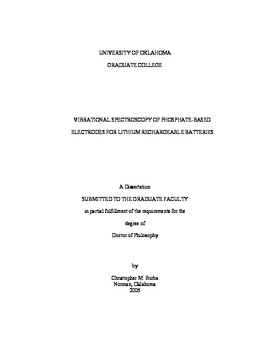| dc.contributor.advisor | Frech, Roger, | en_US |
| dc.contributor.author | Burba, Christopher M. | en_US |
| dc.date.accessioned | 2013-08-16T12:20:00Z | |
| dc.date.available | 2013-08-16T12:20:00Z | |
| dc.date.issued | 2006 | en_US |
| dc.identifier.uri | https://hdl.handle.net/11244/968 | |
| dc.description.abstract | The favorable energy densities and cycling performances attainable from lithium rechargeable batteries has prompted aggressive research in this field for over 30 years. In particular, phosphate-based electrodes receive much attention due to their competitive redox potentials, capacities, and enhanced safety compared to currently commercialized systems. In developing these materials, it is critical to have a good understanding of the fundamental reactions that occur during cycling. Vibrational spectroscopy is particularly useful in this regard because it is sensitive to the local structure of the electrodes. However, few researchers use vibrational spectroscopy to study lithium intercalation in phosphate-based electrodes. The intramolecular vibrations of the phosphate anions yield intense bands in the Raman and infrared spectrum that are sensitive to the immediate local environment of the phosphate anions; thus they are natural candidates for the technique. Measuring the infrared or Raman spectrum of these materials at various states of charge can provide a wealth of information about local structural changes and charge compensation reactions occurring within an electrode from the perspective of the phosphate anions. | en_US |
| dc.description.abstract | The first objective of this dissertation is to examine lithium intercalation with vibrational spectroscopy for three families of phosphate-based electrodes: phospho-olivine LiMPO4 (M = Fe, Mn) cathodes, LISICON Li3 M2(PO4)3 (M = V, Ti) cathodes, and LiSn2(PO4)3 and Sn3(PO4) 2 anodes. Symmetry-based analyses are used to interpret the vibrational modes of each compound. Vibrational spectra recorded at various states of charge demonstrate the sensitivity of the phosphate anions to the presence of lithium ions and provide insight into the lithium intercalation reactions that occur within these materials. The second objective of this dissertation is to describe new in situ electrochemical cells for Raman and infrared spectroscopy. For example, a relatively cheap in situ Raman cell based on modified coin cells is tested with V2O 5 cathodes. The field of in situ infrared spectroscopy is extended to include transmission experiments. The performance of a new in situ transmission FT-IR spectroelectrochemical cell is tested with FePO4 cathodes, and the results agree very well with ex situ experiments. Both techniques provide new ways to study lithium intercalation for a range of advanced electrode materials. | en_US |
| dc.format.extent | xix, 205 leaves : | en_US |
| dc.subject | Lithium cells. | en_US |
| dc.subject | Chemistry, Physical. | en_US |
| dc.subject | Storage batteries. | en_US |
| dc.subject | Vibrational spectra. | en_US |
| dc.subject | Clathrate compounds. | en_US |
| dc.title | Vibrational spectroscopy of phosphate-based electrodes for lithium rechargeable batteries. | en_US |
| dc.type | Thesis | en_US |
| dc.thesis.degree | Ph.D. | en_US |
| dc.thesis.degreeDiscipline | Department of Chemistry and Biochemistry | en_US |
| dc.note | Adviser: Roger Frech. | en_US |
| dc.note | Source: Dissertation Abstracts International, Volume: 67-01, Section: B, page: 0286. | en_US |
| ou.identifier | (UMI)AAI3205285 | en_US |
| ou.group | College of Arts and Sciences::Department of Chemistry and Biochemistry | |
